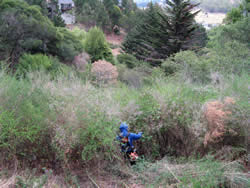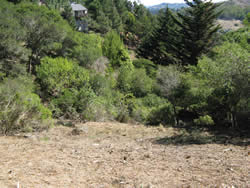Forests and Rangelands Success Story
Community Commitment to Fire Safety in Marinview
Golden Gate National Recreation Area, California
National Fire Plan - Community Assistance
2008

Durant Fuel Treatment Area in Marinview before work completed in 2008.

Durant Fuel Treatment Area in Marinview after work completed in 2008.
Marinview knows about defensible space. During the winter of 2008, Southern Marin Fire Protection District (SMFPD) conducted a risk assessment on every structure in the subdivision in order to prioritize areas for treatment in the Marinview Fire Mitigation Project. The project is being coordinated by the Marinview Homeowners’ Association (HOA) Emergency Preparedness Committee and received $48,500 in funding through a National Fire Plan Community Assistance grant from the National Park Service. The Marinview subdivision consists of 243 homes in Tamalpais Valley, bordering Golden Gate National Recreation Area (GGNRA), and other public lands owned by Marin County Parks and Open Space District, the Tamalpais Community Services District (TCSD), and the Marin Municipal Water District.
"It was important to hone in on areas the fire department felt needed immediate attention," said Gary Miltimore, Natural Resource Manager for Marin Conservation Corps (MCC), who developed the project proposal and received the grant on behalf of Marinview HOA. MCC was glad when SMFPD took the lead on risk assessment because, "The goal [of creating defensible space] is to support the fire departments in being able to do their job."
"Vegetation is the main problem, but there is also a lot of wood siding on the homes in Marinview," said SMFPD Captain Cary Gloeckner, who completed the risk assessments. Gloeckner’s defensible space recommendations often exceeded the basic requirement of 100 feet, due to the steep topography in many areas of Marinview.
Areas were prioritized for treatment based on Gloeckner’s assessments which used the National Fire Protection Association’s (NFPA) Standard for Reducing Structure Ignition Hazards from Wildland Fire (NFPA 1144) to evaluate risk. Areas with more high-risk properties clustered together were considered the highest priority for treatment because work in those areas would protect the greatest number of homes. By June 2008, approximately 20 acres had been treated, creating defensible space for 35 structures, and leaving $14,000 for additional work later in the summer.
Priority Treatment Areas
The first area treated in 2008 was on TCSD and GGNRA lands adjacent to Marinview homes on View Park and Deer Trail. A shaded fuelbreak was created on a densely vegetated slope behind the homes. The work involved thinning and limbing bays, oaks and madrone; removing dead trees killed by Sudden Oak Death; and removing other dead material in the understory.
The next area treated was the southeast side of Via Rocodo below Durant Way and above Carrera Drive near several multi-family structures. "At this location, there were more people who would be affected by a fire," Gloeckner explained. "We also considered the number of possible ignition sources such as vehicles on Tennessee Valley Road, power lines, and secluded places where kids play," he added. This part of the work involved limbing pines and thinning brush on a south facing slope.
The remainder of the grant was used on Marin County land below Durant Way to remove resprouting eucalyptus, cut grass, and thin brush.
Community Participation
Since October 2007, Marinview’s Emergency Preparedness Committee has garnered matching contributions from the community valued at $36,000. The community organized and publicized 4 community meetings; organized a meeting between the HOA and adjacent public land management agencies; contributed labor during chipper days; paid for the rental of chippers; compiled requests for risk assessments; paid for additional fuel reduction on private land; provided postage for 4 mailings; cleared trails; pulled weeds; and paid for tree pruning.
According to Captain Gloeckner, the greatest incentive for community participation in the defensible space program was free chipping of yard waste. The HOA spent $3,500 on chipper days in January 2008. After the first day, it was clear that they were going to be overwhelmed, so TCSD brought in a second chipper.
"There wasn’t a square inch of sidewalk that wasn’t covered in brush…," said Glockner, describing the piles of vegetation residents wanted to remove from their properties. The chips were loaded and deposited at TCSD where they were made available as free mulch. The leftover material was transported to green waste sites for disposal.
Long Term Planning and Success
Marinview is establishing a great track record. In 2000, they received approximately $34,000 from the California Department of Forestry and Fire Protection (CAL FIRE) to treat 11 sections of non-federal open space surrounding Marinview that had been identified in the 1999 Draft Marin County Fire Plan. In 2002, another $30,000 was provided to FIRESafe MARIN for work in Marinview through a National Park Service community assistance grant. These funds were used to treat 21 acres within the subdivision, completing more of the work outlined in the Draft Marin County Fire Plan. In 2008, Marin Conservation Corps received another grant for $53,400 to continue the 2007 fire mitigation project with more fuel reduction on public land as identified in the risk assessments.
After initial treatment, maintenance projects will be less expensive. Marinview’s commitment to fire safety is a great example of what it takes to establish a long-term wildfire protection plan, and work toward achieving it.
Contact: Jennifer Chapman, Fire Communication and Education Specialist, (415) 464-5133.